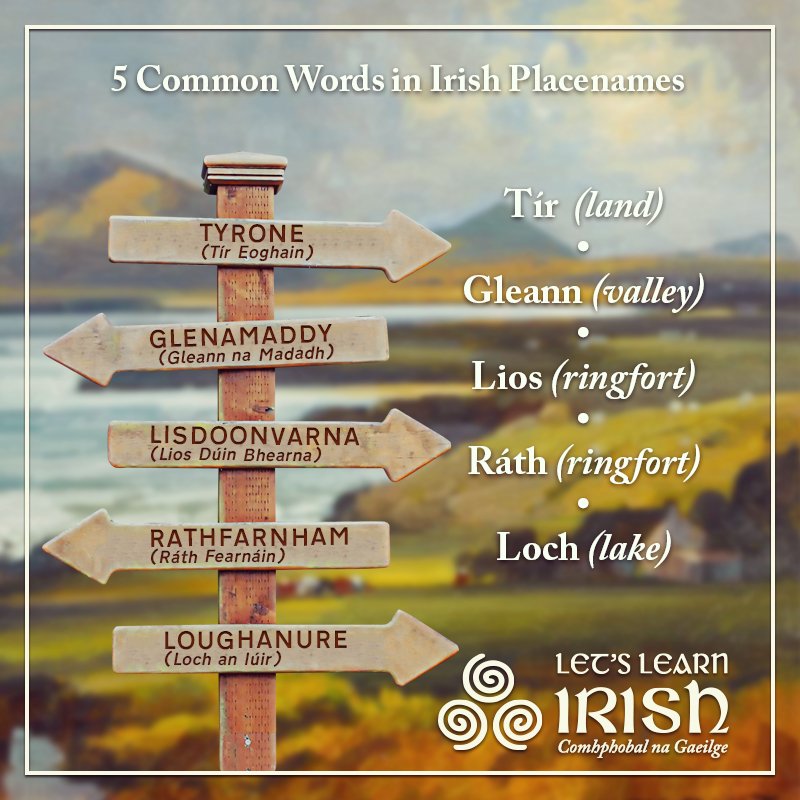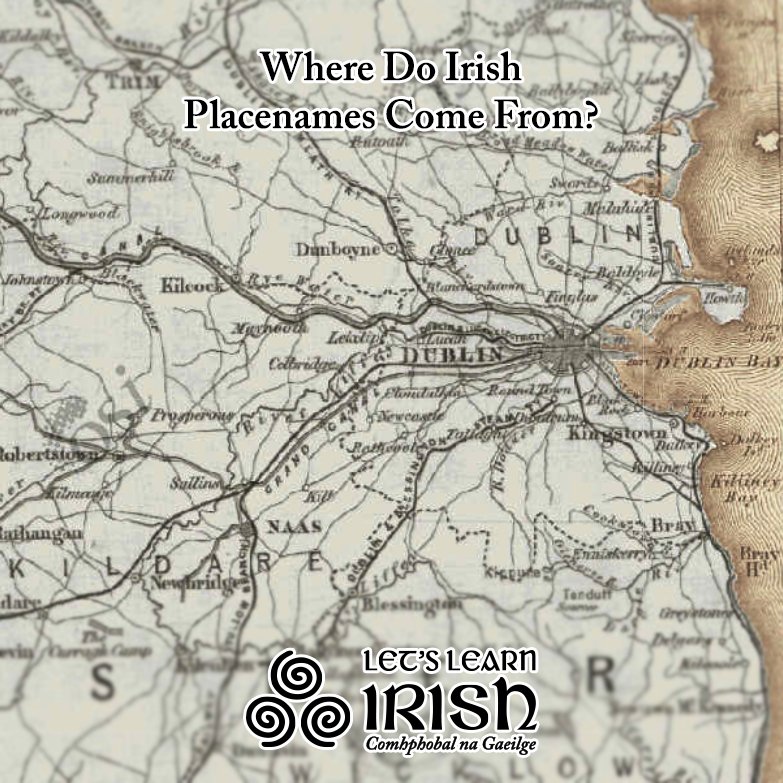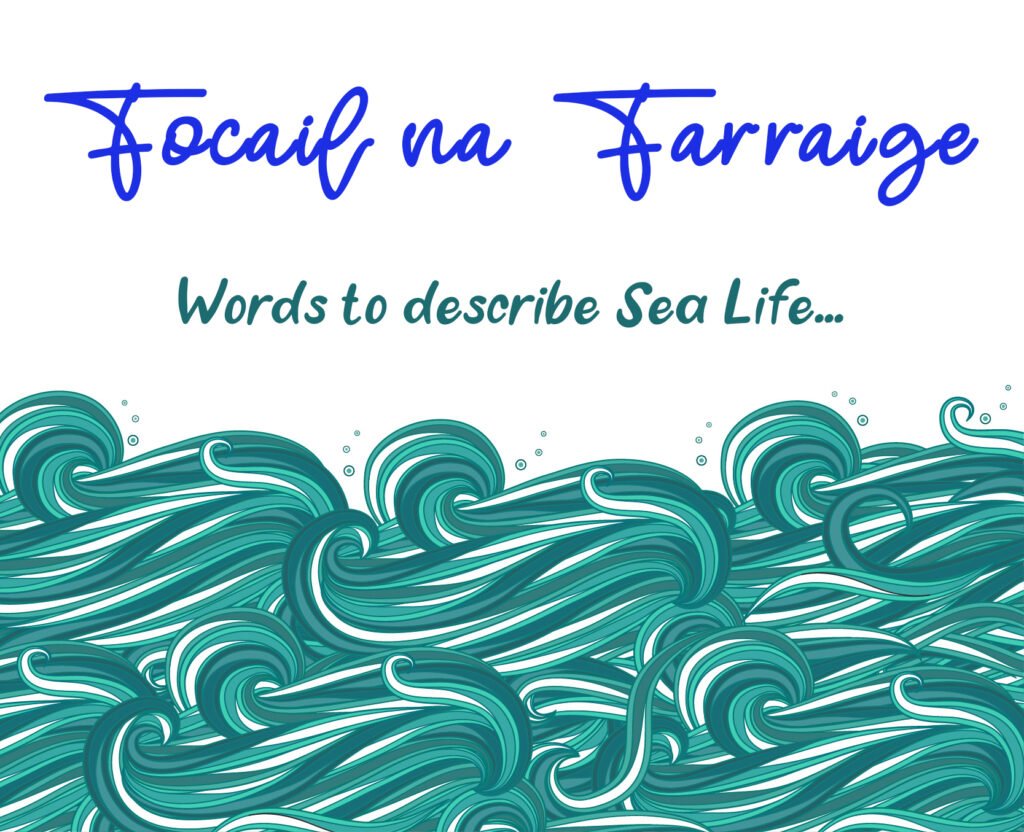Irish Placenames: Ard, Áth, Bád, Baile, Cill, Carraig
Logainmneacha / Placenames
 The vast majority of the placenames (‘logainmneacha’) we use in Ireland are anglicisations of the original Irish language names, and it can be fun to decipher their meanings! These names reveal hidden histories, legends, mythologies and indeed, the evolution of the Irish language. On occasion, the etymology is unclear, but in such instances, we can draw upon local topography and tales to make an informed guess. It’s no surprise that these ‘logainmneacha’ emphasise the physical features of their areas – for example, the local hills, woods, meadows, trees, fords, bridges and forts all feature prominently.
The vast majority of the placenames (‘logainmneacha’) we use in Ireland are anglicisations of the original Irish language names, and it can be fun to decipher their meanings! These names reveal hidden histories, legends, mythologies and indeed, the evolution of the Irish language. On occasion, the etymology is unclear, but in such instances, we can draw upon local topography and tales to make an informed guess. It’s no surprise that these ‘logainmneacha’ emphasise the physical features of their areas – for example, the local hills, woods, meadows, trees, fords, bridges and forts all feature prominently.
Below we’ll look at the following logainmneacha: Ard (high), Áth (ford), Bád (boat), Baile (town), Cill (church) and Carraig (rock). As you study these examples, you’ll begin to notice patterns and recognise vocabulary. You might also like to check out our article focusing on examples using Cluain, Cnoc, Coill, Droim and Dún, and another one on Tír, Gleann, Lios, Ráth and Loch!
Ard
Let’s look at some examples of places with the word ‘Ard’, meaning ‘high’…
Ard Fhearta (Ardfert), meaning ‘hill of miracles’, is a village in Co. Kerry, Ireland.
Ard an Rátha (Ardara), which translates as ‘height of the fort’, is a small town in Co. Donegal.
Ard Raithin (Ardrahan), referring to a ‘high ringfort’, is a village in Co. Galway.
Ardach/Ardachadh (Ardagh), meaning ‘high field’), is a village in Co. Longford and also in Co. Limerick.
The townlands of Ardráth (Ardragh), in Co. Monaghan and Co. Tipperary, no doubt refer to a local ‘high fort’.
Ardachadh (Ardaghy) in Co. Monaghan, refers to a ‘high field’.
Aird Mhór (Ardmore), meaning ‘great height’, is located in Co. Wicklow, and home to the famous Ardmore Studios. Films such as Braveheart, My Left Foot and Excalibur have all been filmed there. Incidentally, Irish mythology features Caladbolg (meaning ‘hard belly’ or ‘hard lightning’), the sword of Fergus Mac Róich that’s known for its incredible power. Caladbolg is the name that Fergus calls this sword in Táin Bó Cúailnge; several commentators have seen this tale as a basis for the Arthurian legend of Excalibur!
Áth
‘Áth’ appears in many placenames, and usually in reference to a ford…
Baile Átha Luain (Athlone town, in Co. Westmeath), refers to the ‘town of Luan’s ford’.
Áth an Choite (Annacotty) is a town on the outskirts of Limerick city, and means the ‘ford of the small boat’.
Áth na mBó (Annamoe) in Co. Wicklow, refers to the ‘ford of the cows’. This picturesque village has been home to celebrities and artists such as Daniel Day Lewis, Paul McGuinness, Paddy Moloney and John Boorman, the director of the aforementioned Excalibur.
Baile Átha Cliath (Dublin City), means ‘town of the hurdled ford’. Incidentally, the name Dublin originates from the Irish ‘dubh’ (black) and ‘linn’ (pool), a reference to the ‘black pool’ formed where the River Liffey and the Poddle stream met at Dublin Castle. The development of Dublin City means that the Poddle is no longer visible in the city centre.
Bád
‘Bád’, meaning ‘boat’, appears in a number of placenames near coastal areas…
Dún an Bháid (Donabate, Co. Dublin), refers to the ‘fort of the boat’.
Creag an Bháda (Craigavad, Co. Down), translates as ‘rock of the boat’.
Gleann an Bháid (Glanavaud, Co Cork), means ‘valley of the boat’.
Other examples include:
Bá na mBád (Boat Bay) in Co. Donegal.
Caladh an Bháid (Boat Cove), Co. Kerry.
Trá an Bháid (Boat Strand), Co. Waterford.
Díog na mBád (The Boat Trench), Co. Louth.
Baile
There’s no shortage of Irish towns featuring ‘Bally’ or ‘Ball’ at the start of their names, which originates from the Irish word ‘Baile’, meaning ‘town’, or ‘Béal’, meaning ‘mouth’. Here are some examples of both…
Baile an Mhóta (Ballymote), in Co. Sligo, translates as ‘town of the motte/mound’.
Baile an Locha (Ballinlough), a village in the west of Co. Roscommon, refers to the ‘town of the lake’.
Baile Uí Dhálaigh (Ballygawley), in Co. Tyrone, refers to ‘Ó Dálaigh’s town’.
Baile an Tí Mhóir (Baltimore), meaning ‘town of the big house’, is a village in western County Cork…and is also the name of Maryland’s most populous city!
Béal an Átha (Ballina), the largest town in County Mayo, is located at the mouth of the River Moy near Killala Bay, in the Moy valley. It’s name translates as ‘mouth of the ford’.
Béal Átha Beithe (Ballybay), meaning ‘mouth of the ford of the birch’, is located in Co. Monaghan.
Béal an Dá Chab (Ballydehob), a coastal village in southwest Co. Cork, translates as ‘mouth of the two river fords’.
Cill
Considering the spiritual history of Ireland, it’s no surprise that there are many references to churches, burial places and holy wells in the local placenames. The word ‘Cill’, meaning ‘church’, appears regularly throughout the island…
Cill Dara (Kildare) is a town in Co. Kildare, and its name translates as ‘church of the oak’.
Cill Airne (Killarney), which translates as ‘church of sloes’, is a town in south-west Kerry. Sloes are the fruit of the blackthorn, a thorny shrub with dark purple berries, and these berries can be picked in autumn to make country wine or sloe gin!
An Chill (Kill), meaning ‘the church’, is a village and parish in Co. Kildare, close to the Dublin border.
Na Cealla Beaga (Killybegs) is a town on the south coast of Co. Donegal. It is the largest fishing port in Ireland. Na Cealla Beaga translates as ‘little cells’, a reference to its early monastic settlements.
Baile an Chillín (Ballinkillin/Ballinkillen), meaning ‘settlement of the cillín’, is a small village in Co. Carlow. A cillín (plural cilliní) are historic sites primarily used to bury stillborn and unbaptised infants.
Cill na Móna (Kilnamona), meaning ‘church of the bog/marshy field, is located in Co. Clare.
Cill Iníon Léinín (Killiney), meaning ‘church of the daughters of Léinín’, is an affluent seaside resort in south-east Co. Dublin.
Cill Chiaráin, a coastal village in Conamara, Co. Galway, is named after Saint Ciarán. It shares its name with a second Cill Chiaráin, located in Co. Kilkenny.
The townland of Cill an Chairn (Kilcarn) in Co, Meath, means ‘church of the carn/heap’, and it reportedly gets its name from a nearby fort.
Cill na Seanrátha (Killashandra), is a village in Co. Cavan, and its name means ‘church of the old rath/ring-fort’.
Carraig
The term ‘Carraig’ typically refers to ‘a rock’. Examples of Irish placenames with ‘carraig’ include…
Carraig Álainn (Carrigallen), meaning ‘beautiful rock’, is a small village in Co. Leitrim.
Carraig na Siúire (Carrick-on-Suir), meaning ‘rock of the Suir’, is a town in Co. Tipperary.
Carraig Mhachaire Rois (Carrickmacross), which translates as the ‘rock of the wooded plain’, is a town in south Co. Monaghan.
Carraig Fhearghais (Carrickfergus), meaning ‘Fergus’ rock’, is located a short distance outside Belfast city, in Co. Antrim, and is notable as one of Ireland’s oldest towns. It is also the subject of the classic Irish folk song, “Carrickfergus”, which itself is a 19th-century translation of an Irish-language song, Do Bhí Bean Uasal, written by the Irish bard Cathal “Buí” Mac Giolla Ghunna. The song opens with the famous line, “I wish I was in Carrickfergus…”
Carraig na gCailleach Dubh (Carricknagalliaghduff) in Co. Mayo, is amongst the longest placenames in Ireland! It refers to a rock of a black nun, hag or witch… This name also brings to mind places such as Mainistir na gCailleach Dubh (Monasternagalliaghduff), meaning ‘Black Nuns’ Abbey’, a ruined Augustinian abbey in Co. Limerick. Bear in mind that Cailleach can refer to a “veiled one”, such as a nun, but also a goddess, old witch, druid or even the cormorant bird.
Join the online Irish community for cúrsaí, comhrá & ceardlanna, and follow along on social media @LetsLearnIrish – beidh fáilte romhat!






